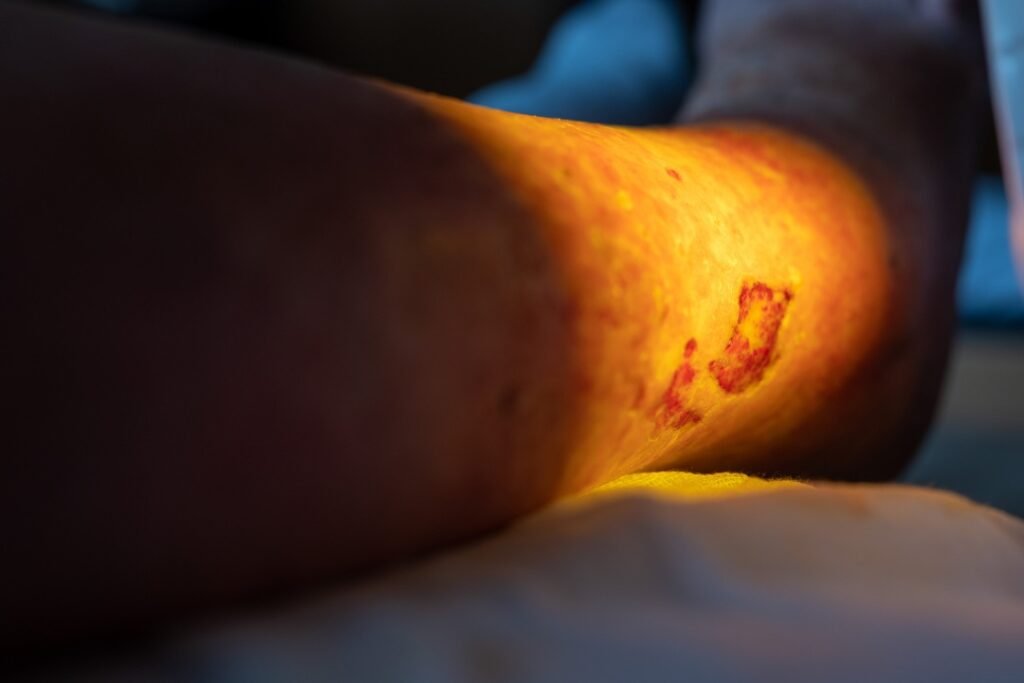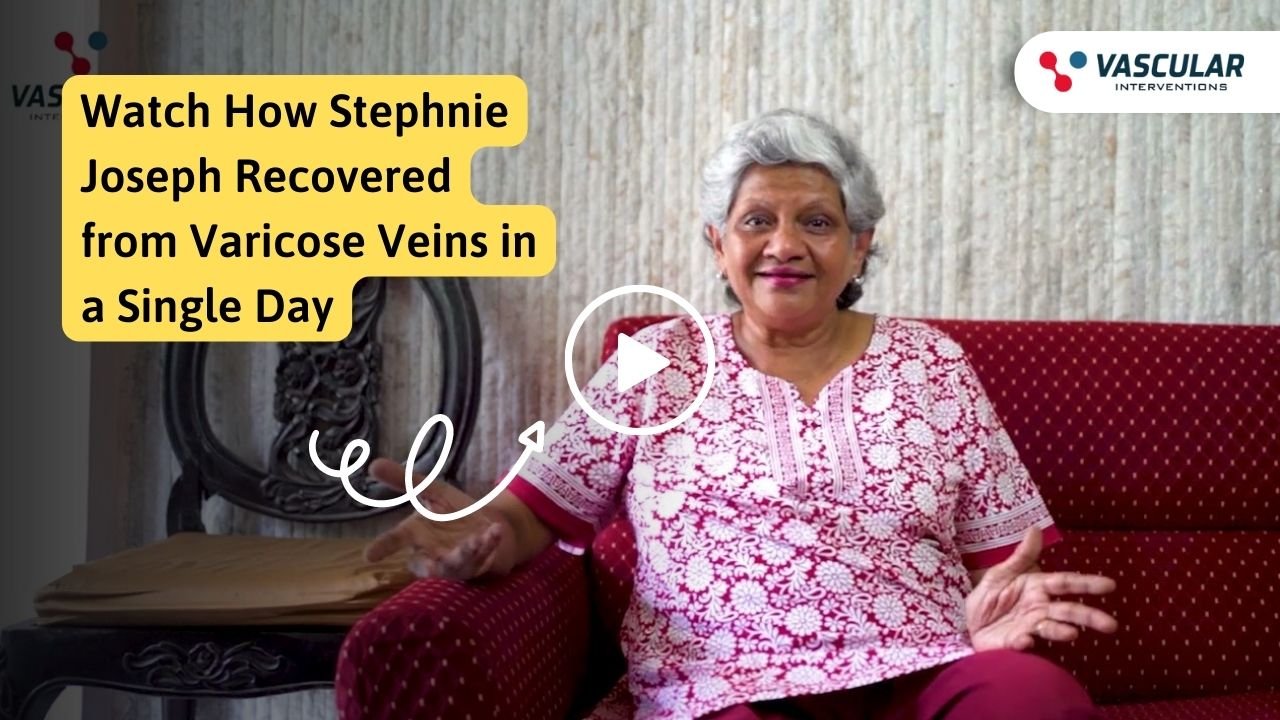Advanced Venous Ulcer Treatment in Mumbai
Get relief from painful, unsightly Venous Ulcer in Mumbai.

Advanced Venous Leg Ulcer Treatment in Mumbai
Living with a sore on your lower leg can be more than just uncomfortable – it can make you hold back from simple things, like wearing your favourite sandals or taking an evening walk by the sea.
Maybe you’ve tried home remedies, changed dressings every day, or even waited months hoping it would heal on its own. When it doesn’t, it’s easy to feel stuck and frustrated.
You’re not alone. In Mumbai, many people face the same struggle, often without realizing that the source of the problem is in their veins.
At Dr. Jathin’s Vascular Interventions & Varicose Vein Center, we take the time to listen and understand exactly how your ulcer affects your life – whether it’s pain when you stand, trouble sleeping because of the ache, or avoiding social plans out of embarrassment.
Dr. Jathin Rai is one of the best interventional radiologists in Mumbai, who’s spent over ten years helping patients stop the cycle of non-healing wounds.
He starts with a simple, painless ultrasound scan to see where blood is getting stuck, then offers treatments that work from the inside out – so you can finally change that dressing for the last time.
What Is a Venous Ulcer?
A venous leg ulcer is an open sore on your lower leg – most often just above the ankle – that won’t heal on its own because of faulty veins.
Instead of fresh blood being carried back up to your heart, it pools in the legs.
That extra pressure damages the skin and prevents wounds from closing.
Here’s how it happens in simple terms:
- Faulty Valves : Veins have tiny one-way valves that keep blood moving up. If these valves weaken or fail, blood drips back down and gathers in the leg.
- Poor Oxygen Supply : Pooled blood means the skin and tissues don’t get enough oxygen and nutrients. That makes it easier for a wound to form and harder for it to heal.
- Skin Breakdown : As pressure builds, the skin becomes thin, fragile, and eventually breaks open, creating a stubborn ulcer.
- A shallow, irregular-shaped wound between your knee and ankle
- Dark or reddish-brown skin around the sore
- Swelling or heaviness in your lower leg
- Discomfort that gets worse when you stand or sit for long periods
Causes of Venous Leg Ulcers
Venous leg ulcers don’t just happen by chance, they usually start because something is blocking or slowing the flow of blood out of your lower legs.
When blood pools around your ankles, it puts extra pressure on the skin and tissues, making them fragile and prone to open sores.
Here are the most common causes:
- Leaky Vein Valves : Tiny one-way valves inside your leg veins keep blood moving upward. If they weaken or fail, blood drips back down and gathers in the lower leg.
- Varicose Veins : These bulging, twisted veins make it even harder for blood to flow out, raising pressure in nearby tissues and leading to skin breakdown.
- Past Deep Vein Thrombosis (DVT) : A blood clot in a deep vein can leave scarring or damage behind. Even after the clot clears, blood flow may remain poor, setting the stage for an ulcer.
- Long Periods of Standing or Sitting : Staying on your feet all day (like at a shop counter) or sitting still for hours reduces the calf-muscle “pump” that normally pushes blood back to your heart.
- Injury or Surgery to the Leg : Cuts, scrapes, insect bites, or past operations can damage local veins or thin the skin. In areas with already poor circulation, even a small wound can turn into a lasting ulcer.
- Other Health Factors :
- Age: Vein walls weaken as we get older.
- Weight: Extra weight adds stress to leg veins.
- Smoking: Nicotine narrows blood vessels and slows healing.
- Diabetes & High Blood Pressure: Both conditions can make it
- Diabetes & High Blood Pressure: Both conditions can make it harder for your body to repair damaged tissue.
By understanding what led to your ulcer, you’ll see why treating the underlying vein problem is so important.
Next, let’s look at the Symptoms of Venous Ulcer to Watch For—so you can recognise warning signs early and get the right care before the ulcer deepens.
Symptoms of Venous Ulcers
When the veins in your lower legs can’t move blood back up properly, you may start to notice warning signs before a full ulcer develops.
Spotting these symptoms early can help you seek treatment for Venous Leg Ulcer before the sore gets deeper and more painful.
- Aching or heavy feeling in the lower leg
- Swelling around the ankle or calf
- Visible varicose veins (bulging, twisted veins)
- Brownish or reddish patches on the skin
- Dry, itchy or tight skin
- An open sore that oozes fluid or forms a crust
- Tenderness or burning pain at the ulcer site
If you notice one or more of these symptoms—especially an open sore that doesn’t heal in a couple of weeks—don’t ignore it.
Next, we’ll explore the different stages of venous ulcers so you can see where yours fits and understand what treatment steps make the most sense.
Looking for Venous Leg Ulcer Treatment in Mumbai?
Consult the best vascular surgeon Now!
Stages of Venous Ulcers
Venous leg ulcers usually don’t appear overnight. They develop in steps, and knowing which stage at your ulcer is based on the symptoms we discussed above helps us choose the right treatment for your venous ulcer.
Stage 1 – Skin Changes
- No open wound yet
- Dark or red patches, swelling, itching
Stage 2 – Shallow Ulcer
- Small, shallow sore appears
- May ooze clear fluid and form a crust
Stage 3 – Deeper Ulcer
- Wound grows wider or deeper into the skin
More fluid, increased pain, possible odor
Stage 4 – Complicated Ulcer
- Ulcer reaches muscle or tendon
- Signs of infection (redness, warmth, pus)
- Healing without specialist care becomes very difficult
Understanding these stages of venous ulcers makes it clear why a proper check-up by an expert varicose veins surgeon is so important.
Now you have a question: why do these venous ulcers take so long to heal? Let’s understand this from one of the best vascular surgeons in Mumbai, Dr Jathin.
Why Venous Ulcers Don’t Heal Easily
Think about the last time you knocked your knee or cut your finger – within days, your body patched itself up and you probably barely noticed it afterward.
Now imagine a sore on your lower leg that stays open for weeks, even months, no matter how many times you change the dressing or soak it in antiseptic.
That’s the reality of a venous leg ulcer. It isn’t just a stubborn wound; it’s a sign that something deeper isn’t working right.
- Blood Pools in the Legs
- Ongoing Swelling and Inflammation
- Thin, Fragile Skin
- Higher Risk of Infection
- Other Health Factors
- Reduced Movement
Unfortunately, less movement means poorer muscle pumping action, which makes blood pooling even worse
Simply wrapping your leg in bandages may ease the pain for a moment, but it won’t heal the ulcer.
So, how exactly do we help your ulcer heal with our advanced Venous (Leg) ulcer treatment in Mumbai?
How We Treat Venous Ulcers in Mumbai
Treating a venous leg ulcer means more than just covering the sore.
It’s about finding the vein that’s causing the problem, fixing it, and then giving your wound the best environment to heal. At Dr. Jathin’s Varicose Veins Center, we follow three simple steps:
- Accurate Diagnosis :
- Painless Doppler Ultrasound: A quick scan shows exactly where blood is getting stuck.
- Clinical Exam: We look for swelling, skin changes, and varicose veins to map out the trouble spots.
- Effective Vein Treatment :
- Endovenous Ablation: A thin fibre uses heat to seal the faulty vein from the inside so blood reroutes through healthy veins.
- VenaSeal™: A medical glue closes the problem vein without any heat—perfect for patients who need a gentler option.
- Wound Care & Dressings :
- We use modern, moisture-balancing dressings that protect the ulcer, prevent infection, and speed up skin regrowth.
- Regular follow-ups ensure dressings are changed on time and healing stays on track.
These three steps, finding the leak, fixing the vein, and caring for the wound work together to tackle the root cause and help your ulcer finally close
Ready to Heal?
You don’t have to live with a painful, slow-healing leg sore.
With the right diagnosis, vein treatment, and wound care, you can close that ulcer for good and get back to wearing your favourite shoes and moving without worry.
At Dr. Jathin’s Vascular Interventions & Varicose Vein Center, Dr. Jathin combines over ten years of experience in vein interventions with a caring approach to guide you through every step from painless Doppler scans to targeted treatments like Endovenous Ablation and VenaSeal™, plus modern dressings that help your skin repair itself.
Why Dr. Jathin's Vein Center is a Good Choice:
At his Varicose Vein Center in Mumbai, Dr. Jathin uses the latest methods to treat varicose veins. He is known for providing treatments that are suited to each patient’s needs.
He focuses on more than just the symptoms and looks at the underlying causes to give patients long-lasting relief and better health.
No matter if your varicose veins are just starting to show or if you need more advanced care, Dr. Jathin’s Varicose Vein Center is ready to provide top-quality varicose veins treatment in Mumbai.
Varicose Veins FAQs
Before your Varicose Veins are deep and bulging, usually at the back of your leg, they
can be treated with phlebectomy – a simple procedure that removes the vein. However,
after they are deep and aggressive, treatment can be challenging. There are several
treatment options available, such as sclerotherapy, sclerosant or Veinwave. We at Dr Jathin’s Varicose Vein Center provide the best treatment for varicose veins. Book an Appointment with us to treat your varicose veins.
The procedure typically takes approximately 30 minutes.
Patients report only a small degree of discomfort during treatment, which they say is
tolerable. Dr. Jathin and staff go out of their way to provide a calm, relaxing
environment.
There is no downtime with this procedure- patients can immediately resume work and
almost all normal activities.

Make Your Appointment
Feel free to reach us if you’re in search of the best vascular surgeon in India.


